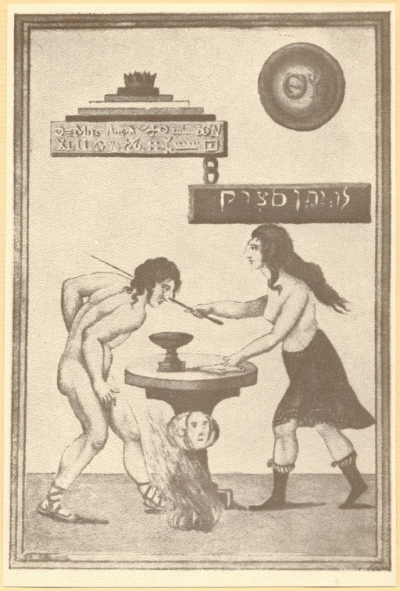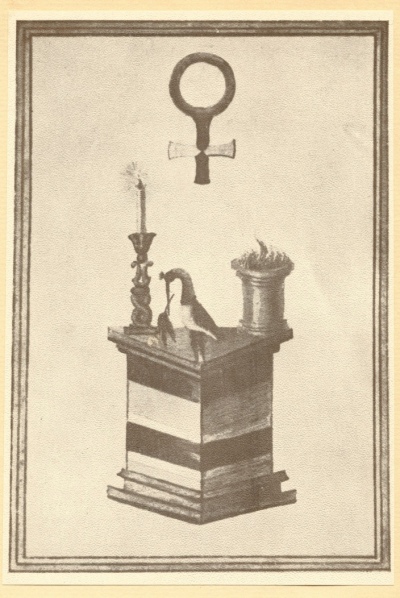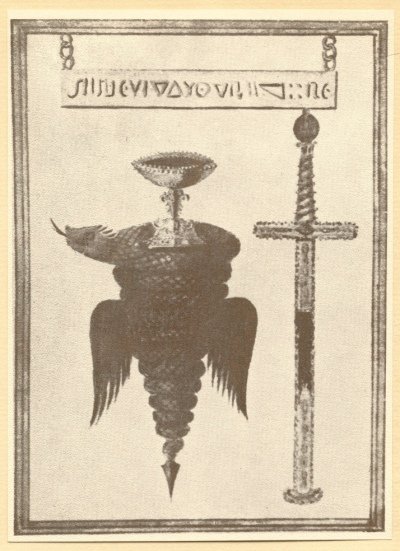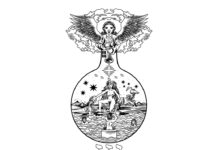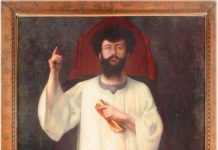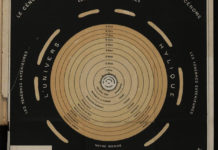Comparing the Martinist & Rosicrucian Legend
Over the last few post I have hinted at an underlying Rosicrucian philosophy known as Pansophy. Though it has largely been untold outside of Pansophic circles this post will reveal a most important ‘secret system’ behind this hidden doctrine. Typically held within older Pansophic circles in Germany and Italy this blog post is going to change the way people see the Rosicrucian legend.
This is in fact my third post on the subject of Pansophy.
At the same time it is also the second installment of the Martinist Order Review
in my ‘Reviews of the Rosicrucian Orders’ series.
As mentioned before most people consider the Rosicrucian body separate from the Martinist. Yet as shown in my last post in terms of their traditional origins it appears that Saint Martin was in fact a member of the Rose Croix d’Orient and parts of the Martinist rituals prep one towards this higher secret body. The proof is only in the pudding as they say.
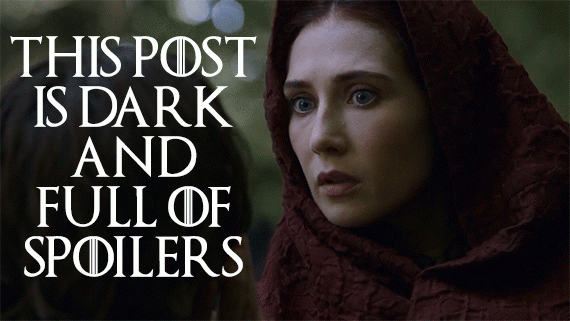 A comparison of the two theologies, that of the Rosicrucians and that of the Martinists, proves their connection once and for all.
A comparison of the two theologies, that of the Rosicrucians and that of the Martinists, proves their connection once and for all.
As my previous posts have shown the theological system of the Rosicrucians is actually called ‘Pansophy.’ The theological system of the Martinist is called ‘Theosophy.’ Some people might be unfamiliar with these concepts so let’s recap for a moment.
First Martinism; simply put Louis Claude de Saint Martin was the founder of the Martinist tradition. Not the source for his vein of writing, his works are considered a part in the thread of writings known as European Theosophy. This is not the Theosophy (Theo-silly) of Blavatsky, but rather that of Jacob Boehme, to whom he always points us towards. There are several brilliant Theosophic writers. All of their works contain similar themes, such as the fall of Adam, the coming of Christ, and most importantly they are Sophianic. Wisdom takes providence here as the great rebirther.
Secondly Rosicrucianism; largely forgotten, we have seen that Pansophy was at the roots of the R.C phenomena. Early Rosicrucian documents use the term ‘Panshophiae,’ and a Circle of Pansophists in Silecia shows a thread running from John Dee to Jacob Boehme via Postel & Frankenburg. The writers of the Rosicrucian manifestos were in contact with Comenius who coined the term Pansophy as well. There are two levels to Pansophy. The first we have seen revealed a system whereby the light of occultism wouldn’t remain strictly occult, but would manifest in society through education. Its’ goal of this application was to establish a new worldly consciousness, known as the utopian City of the Sun.
Readers should refer to my two previous posts on Pansophy
- Part 1 explained a one page historical intro to Pansophy.
- Part 2 explained the utopian quest of Pansophy for all humanity.
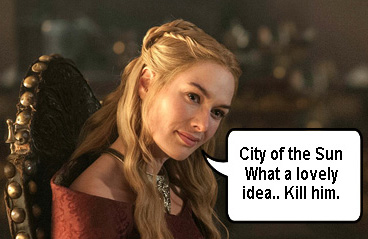 The other element of Pansophy I hinted at, in the Rosicrucian Pillars Scoring System, was that Pansophy has a mythic cycle and offers Hermetic personifications of Christian mysticism.
The other element of Pansophy I hinted at, in the Rosicrucian Pillars Scoring System, was that Pansophy has a mythic cycle and offers Hermetic personifications of Christian mysticism.
For example in the first true Rosicrucian manifesto the sun god Apollo appears, declaring that seven sages must come forth to reform the world. In the final manifesto known as the ‘Pegasus’ Apollo appears again to see what his sages have done.
The three central Rosicrucian manifestos, the Fama, the Confession and the Wedding are a Christian answers those commands, whereby the Greek sages of Apollo incarnate into a Christian civilization to fulfill his grand vision. Several ‘solar city’ models appear in answer as well, modeling either Apollo or Christ at the center of a utopia that is surrounded by seven walls.
The Rosicrucian tomb of Rosenkreuz is a seven-sided microcosm of the same model. Apollo is the ever burning sun above, and the Christ symbol is Christian Rosenkreuz who lies in an immortal incorrupt state in his tomb.
At the same time the Rosicrucian tomb fulfilled an Egyptian prophecy of Hermes, which said that someday the gods would return and be installed inside such a talisman type structure. (Bruno was the one who picked up on this ancient prophecy and transferred that into a talisman city of seven sides. One of his disciples joined the Germans who continued this and transferred that into the seven side tomb of Christian Rosenkreuz in their Fama legend.)
The Rosicrucian writings are simply put BRILLIANT. They interweave so many things it is no wonder I had to score the Amorc ‘new manifestos’ so poorly in comparison.
Finally the Pansophy of the Rosicrucian legend would not be complete without the appearance of a female savior like Sophia, who appears in the ‘Chemical Wedding of Christian Rosenkreuz’ as none other than beautiful Venus herself.
As we have noted Apollo and Venus are not exactly Christian…
Indeed they are prime examples of how Pansophy personifies
the figures of Theosophy into Hermetic themes.
Readers should refer to my two previous posts to catch up on that:
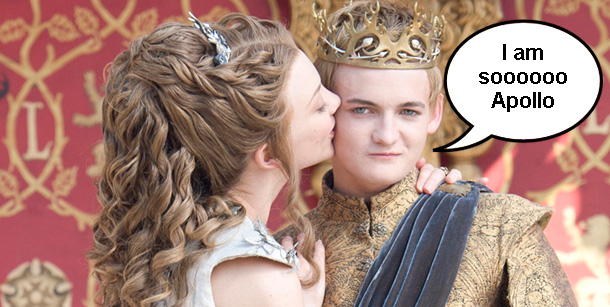
Pansophy is the Hermetic Twin of Theosophy
That’s why Apollo and Venus got the job…
And Poor Christ and Sophia got junked.
One of the most important things my mentor drummed into my brain was that ‘Pansophy was the hermetic twin of Theosophy.’ I was urged to analyze the Rosicrucian manifestos and especially study them in relation to alchemy, alchemical laboratory cycles in particular. As a side by side study I had to examine other legends such as the Exodus of Moses, the legend of King Arthur and see how all of these relate to common themes between Theosophy and Pansophy.
The Christian Rosenkreuz legend is examined against everything else, being the central blueprint for Pansophy, in that its certain ‘phases’ appear in line with all the alchemical themes.
Theosophy in particular is also Hermetic, let’s not forget, but with a Christian covering. The personifications of Theosophy are Christian figures: Adam, Lucifer, Christ, Sophia, the Virgin. But Boehme clearly demonstrates how these cosmic macrocosmic forces are experiences we may have for ourselves as well, we being at certain states and embodying these figures in our own stages of development. Pansophy being a mirror naturally has similar characters in its cycle, just wearing different masks. In particular the figures match Isis and Osiris, with Set in the place of Lucifer.
‘Big DEAL. I have seen this Christ-Horus stuff before.’
REALLY? And You Saw All This in the Legend of C.R.C?
Giving away one of the prized models of Pansophy I’m guessing that some guru type ‘Adepts’ are going to hijack this teaching into their own Orders right after it’s posted. After all a few pennies will drop concerning several temple processes regularly taught. It would be great if this helps a few who have been in the game for years. Just remember folks; you saw it here first.
In so far as Order teachings go no-one is teaching Pansophy in English speaking countries. This blog is the only source, so for those who want to use it please simply reference this work. Also, I have purposefully not given the correct Pansophic titles for the phases as given below so future Order members of the Mystica Aeterna will recognize a real connection to our Order.
Pansophy as the Hermetic twin of Theosophy reveals a side by side correlation of the Christian Rosenkreuz legend with that of the cosmic fall of Adam and Christ regeneration of Boehme. Not only do these phases match up so precisely but they also reveal a hidden Egyptian connection that will leave you with a few question marks… The same symbols appear in various Rosicrucian degrees, in temple furniture and mystical officer stations, showing the signpost of a Pansophic influence.
Traditionally, those Orders that show these Pansophic hallmarks were said to have been influenced by the Unknown Superiors. These signs are the footprints of their invisible presence in an Order’s tradition, thus showing a connection to the True and Invisible Rosicrucians.
It does sound all a bit ‘too fantastic’ but fortunately my mentor was not the only source for this Pansophy/Theosophy twinship. There is just one published source that mentions anything similar.
Arthur Versluis in his ‘Restoring Paradise’ nicely repeats the idea, writing:
“Here we must introduce the word Pansophy or Pansophia. One finds it in the Hermetic publications immediately following the Rosicrucian announcements, as for example Joseph Stellatu’s ‘Pegasus of Firmament, or a Brief Introduction to the Ancient Wisdom, Once Taught in the Magia of the Egyptians and Persians and Now Rightly Called the Pansophia of the Rosy Cross.’ The word Pansophia here separates this new form of esoterism from Theosophia, which is specifically Christian gnosis. Pansophy, in contrast to Theosophy, is universal, not specifically Christian… and draws eclectically on much earlier ‘pagan’ traditions… In many respects, Pansophy resembles the aims and works of Giodano Bruno.”
It is because Martinism is an Order manifestation of the Theosophic stream that I argue that the Martinist Order has one of the strongest alignments to the Rosicrucian current. This also contributes to the overall score of the Martinist Order Review.
Alas, enough of introducing the subject. You may now see for yourself.
INTRODUCING
The Pansophic Legend
Or Otherwise the Philosophers Stone
Personified in Christian Rosenkreuz
Whereby the Egyptian Legend Arrives to Europe
Below you’ll read the Pansophy cycle; or at least a public version for outside the Mystica Aeterna. Bear in mind that this is only an introduction and does not intend to be at all exhaustive. The cycle needs to be repeated over several times from many different angles to perceive its full potential. In this exposure I’ve given an alchemical introduction for each phase, and below that the Rosenkreuz legend is compared side by side with the Theosophy one. As well I have shown the Isis/Osiris connection in the third column. Below those another important note is made of the King Arthur legend and how that too is Pansophic.
Phase One The Breaking Apart
Every good story seems to start with a bit of doom and gloom. Heroes are thrust into such a setting that they may overcome the dark trial. In alchemy the principle material (of transmutation) is broken apart and placed into a phase of darkness. In alchemicy these are called pulverization and putrefaction. The material is left to rot and stew within its own stench. Simply put things are really bad for the legendary heroes when this alchemy phase becomes personified into mythic characters. Here the alchemical matter is cut up (pulverized) into little pieces and sealed within its tomb; being the alchemical glass vessel in which it shall undergo transformation. In the darkened/split-in-half state two beings emerge known as the Solar King and Lunar Queen, who become the dual potencies that struggle against each other in a dark age. All that was is broken.
This split or breaking appears in the legends as follows. Bear in mind that the left column represents Theosophy, the middle column is Pansophic/Rosicrucian and the right is Egyptian:
Legend of Adam
Adam falls.
He was in paradise.
But he becomes broken.
Boehme says he was split into two beings: the lesser Adam and Eve (Solar King/Lunar Queen) who must be united in us.
He is cast out of Paradise.
Legend of Rosenkeuz
Civilization has fallen.
European culture was glorious.
But wisdom has been lost.
Rosenkreuz must go east and west to get the two separate pieces (Solar King/Lunar Queen).
Europe is in darkness.
Egyptian Legend
The rule of the gods is broken.
There was a golden age.
King Osiris is tricked and shut into a coffin.
He is found but Set cuts him up into many pieces (pulverization).
The rule of Set is darkness.
The Cabala also says Adam shattered into many pieces like the broken pieces of Osiris. Boehme’s broken Adam is split into two lesser beings, thus the first fall was when Adam was put to sleep and when he awakens there are two beings, the lesser Adam and Eve.
The coffin of Osiris is the alchemical vessel and as with alchemy Osiris is thrown into a river (submersion). The two polarities appear in the legend of Christian Rosenkreuz where Europe is perceived to have the mystical love of Christ, and the Arabic world is seen to have the intellectual knowledge of Hermes, which are separate. In the meantime Europe was trying to get over the Dark Ages and people were in ignorance. In each case darkness is the central theme, whereby the characters personify the first alchemical phases. Alchemy has now become heroic legend.
In the King Arthur legend Europe has also fallen and the dual forces prepare for battle. In the place of the Set-Satan the symbol of the dragon commences his legend where, like the fallen Adam, our young Arthur is the misfortunate son of Pen-dragon. He grows up in a war-torn world.
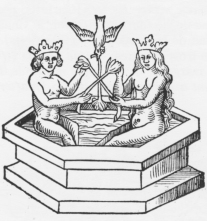
Phase Two The Symbol of Union
Where there is gloom there is always hope. The alchemical components that sit inside the dark vessel have finished rotting, and now out of darkness a new ‘life-force’ begins to rise. This is the fermentation of the substance, being the result of a union between the Solar King and Lunar Queen.
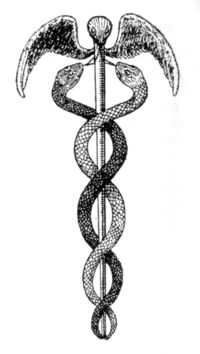 In the course of their union they also die and give birth to a new being. This new being is called ‘Mercury’ in alchemy. As their child he is the union of the dualities that wrestled in darkness. His wand as a symbol of healing is also a symbol of union, shown through the inter-locked serpents around his wand. According to Pansophy there is always some sort of GREAT SYMBOL that reveals the union of oppositions, be they two, three, seven or twelve sides to the opposing polarity. The grand symbol always now appears and always celebrates the end of the dark phase and the light of the new, which is known as the alchemical conjunction.
In the course of their union they also die and give birth to a new being. This new being is called ‘Mercury’ in alchemy. As their child he is the union of the dualities that wrestled in darkness. His wand as a symbol of healing is also a symbol of union, shown through the inter-locked serpents around his wand. According to Pansophy there is always some sort of GREAT SYMBOL that reveals the union of oppositions, be they two, three, seven or twelve sides to the opposing polarity. The grand symbol always now appears and always celebrates the end of the dark phase and the light of the new, which is known as the alchemical conjunction.
Legend of Adam
Parts of broken Adam reconcile. Tribes unite.
Old Testament sees this symbol in the Tabernacle of Moses. 12 tribes surround.
New Testament sees it in Christ and his 12 disciples, as well as the cross.
Legend of Rosenkreuz
Rosenkreuz unites the wisdom of the East and West.
His reconciled knowledge becomes a College of the Holy Spirit.
All forces are shown in union in the seven sided tomb of CRC.
Egyptian Legend
Isis pieces Osiris back together.
She grants him new life through the symbol of the Ankh.
Osiris lord of Hades. He unites dual wands, the crook and scourge.
In each case there are examples of victory over the alchemical death of putrefaction. Adam was cast out of paradise but the new covenant of Moses (OT) or Christ (NT) promise a new life in spirit. Christian Rosenkreuz himself lies in an immortal sleep like state, not yet living, as after all the Mercury is not the Philosophers Stone, but is the revivification of that which was once broken.
Spending time in foreign lands with sages in Egypt and Damascus Rosenkreuz has reconciled this Mercurial intellectual knowledge (the treatises of Hermes/Plato) with that Venetian way of the heart of his Christian land. Like the incorrupt sleeping CRC our Egyptian hero Osiris becomes lord of the afterlife, the two wands in his hand show the union arising out of the life symbol of the ankh of Isis. The scourge whip Osiris holds is a punishment symbol, and the crook of mercy is here crossed over it, (mercy and severity unite) which shows the ancient Egyptian symbol for the union of opposites.
In the King Arthur legend we find a strangely similar motif. The 12 disciples of Christ or the 12 tribes that surrounded Moses are now the 12 Knights of the Round Table. The round table is symbol of peace and union taking the place of the tomb of CRC. Mercury no longer wields his wand arising from alchemical darkness, seeing that Arthur has drawn his sword from the stone.
Need I mention here my previous article on the seven sided tomb of King Athur?
Phase Three The Virgin Appears
The alchemical mercury is placed through a process of distillation, meaning that it is re-purified several times. Thus though there is new life in the alchemical matter, which has begot the new fermented wine, this matter, like the entombed state of CRC/Osiris, needs to re-die, ascend and descend several times. It is a soul without a body. Thus the alchemical sulfur needs to be added. Roger Bacon rightly describes the ‘flowers of Sulfur’ and hints at the rose symbol. Paracelsus says that the Sulfur is ‘narcotic, hypnotic and sweet’ naming several narcotic flowers that are ‘similar.’ Here the mystery of the true Rose unfolds, where most know the Rose as Mary
Legend of Adam
Moses covenant is broken.
Gabriel visit Mary to tell her of her ‘wedding’ and Boehme says the Virgin comes onto Mary as a shroud.
The Virgin is Sophia.
Legend of Rosenkreuz
Venus appears to CRC
She calls him to a Wedding Like Gabriel this Venus has a horn.
Venus tells CRC he is to be the New Kings’ Father and Venus the Mother.
Egyptian Legend
Osiris is in fact slain twice.
Isis as Virgin finds him and wishes to copulate with him.
He has no phallus so Isis attaches a new one. Isis becomes pregnant.
According to Boehme ‘Sophia is the Sulfur.’ Thus we need look no further as to what his religious alchemy means. Clearly Rosicrucian alchemy was not only a laboratory practice but was also a religious mysticism also told in the Chemical Wedding of CRC.
The fifth day in particular mentions CRC shall be the ‘New Kings’ father and Venus the mother. For Boehme the Second Adam is the father of Christ, but this can only take place in the soul when the Virgin attends our mysticism. For her ‘impregnation’ to occur Boehme tells us we must give birth first to the Second Adam, or he calls it the ‘New Will,’ which is the Mercury previously discussed. This New Will is what impregnates the soul of our mysticism, and as Boehme says it must be constantly sacrificed (distillation) and ‘die every day’ in order to invite the Virgin Sophia.
In the King Arthur legend there are in fact two swords as well (think Second Adam and Second Osiris here). The first sword he drew from the stone is broken in battle, but Merlin (Mercury) shows him how to get a new sword from the Lady of the Lake. This Lady of the Lake is the Venus of the Arthur cycle, who also takes on the form of the Grail in the rest of the legend. The sword here is an ideal symbol, seeing that as Jacob Boehme insists we shall attain this ‘New Will’ after the phase of darkness, which was the second phase of the work. I might add that this symbol also appears for the Egyptians as Isis gives the second Osiris a new phallus, which she has made from wood.
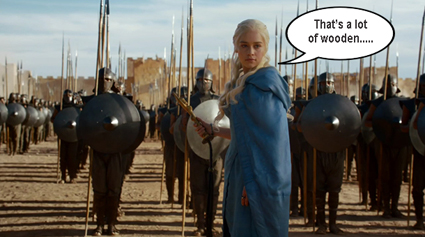
For Rosicrucians this wedding is the new bright red rose that blooms upon the cross. The cross is the undying male figure in his tomb. The symbol is a rose because alchemist have either described the sulfur as a flower or as a narcotic, meaning the mystical enrapture of divine love. The Rose-Cross shows this ‘male will’ uniting with a ‘female power.’
This New Phallus/Sword of the King
as Granted from the Goddess Appears in the Temple
as the Three Sided Shekinah altar.
Commonly Found in Rosicrucian Temples
Naturally it also leads us towards the divine child, being the seventh phase. Anciently the three sided altar or pillar was a symbol for Apollo, who Greek speaking Egyptians called Horapollo, thus they equated him with Horus. In the Chemical Wedding the passage to the chamber of Venus is also triangular, which leads to her bedchamber… where Christian Rosenkreuz sees Venus naked. Thus the ‘Shekinah altar’ is highly significant when it appears inside the Rosicrucian temple.
Let us not wrap up without old King Arthur. In the grail legends the holy chalice itself, carrying the blood of Christ, is in fact seen alongside a second object… During the castle vision of the Wounded King (think Osiris or the incorupt but dead C.R.C) our new hero Percival, as the perfect knight of Arthur, sees not only the Grail but also a bleeding lance… Talk about stick him with the pointy end.

This for now concludes my introduction to some of the inner workings of Pansophy.
Though at first some readers may find it simplistic I can guarantee… there is MORE. Even in this post I’ve literally cut out several phases, meaning this post was the ‘Pansophy Lite’ edition.
For those who thought it would be just another ‘Christ-Horus revelation’ bear in mind that the focus in Pansophy is the female savior figure. In fact the Christ-Horus story as normally given is somewhat displaced, taking the legend out of context. You hardly hear mention of the initial breaking fall or the great universal symbol (table or tomb) showing a reconciliation of the opposites.
The purpose of this post was not to provide a full expose on Pansophy, but instead was given in order to show the close alignment between Theosophy and Pansophy, and thus Martinism to the Rosicrucian current. After all Louis Claude de Saint Martin, the founder of Martinism, was in every way a disciple of Jacob Boehme. That system clearly matches that of the Rosicrucian manifestos.
As stated earlier in this article, really the only difference is that one personifies the story in Christian figures and the other in Pagan ones. Like most twins they ‘think the same thoughts.’
Thus Martinism is closely aligned the Rosicrucian tradition, and as some readers can already see, so is the Golden Dawn… but more on that later. All will be revealed and prove exciting.
As a teaser I will say this; it is actually quite clear that in Pansophy the legend of C.R.C, or the Egyptian cycle of Osiris, or those of Christ or King Arthur can be used interchangeably. This is why an Egyptian type Order may align to the same Pansophic current, just as much as a King Athur type Order would, (providing it has certain Pansophic hallmarks present in its rituals.) Several different types of Orders, though they have different outward ritual appearances, actually have Pansophy as their internal backbone, connecting them all to the same cycle of initiation.
The key is not only shown in the similarity of the legends, but most importantly in the appearance of a Lady of the Lake, or female rebirther that grants some sort of key for the hero to finish their work. For Pansophists this is very true in their own meditative mysticism, which I’ll also explain soon.
If you enjoyed this post please leave a comment. I might just hurry to write the next. Alternatively, you can read the final Martinist Order Review which rounded up the whole series on Martinism.
May the Virgin pour her waters upon your Work, Samuel Robinson.

P.S, check out the Pansophic Keys of Cagliostro/St Germaine from the Trinosophia.
The male assumes the female role and the woman the male commencing the comingling of opposites. Then we see the three sided Shekinah altar, and after that the Sword and the Grail in sequence.
